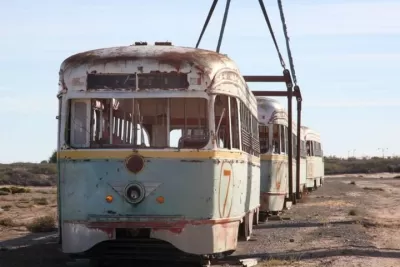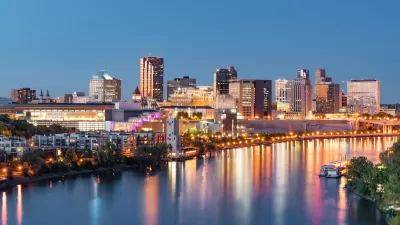The historic streetcars will connect uptown and downtown amenities in a 4.8-mile loop.

The City of El Paso saw the return of its streetcar last weekend, reports Lisa Sanchez, "[e]xciting news for El Pasoans who have missed taking a ride down memory lane in our El Paso Streetcars."
The historic trolleys date back to trolley carts first installed in 1902 to replace the city's mule car system, which then expanded into a full streetcar system that served El Pasoans during the 1950s through 1970s. According to Destination El Paso, "[t]he project began with the construction of 4.8 miles of track, 27 stops, a maintenance and storage facility and associated infrastructure, along with the remanufacture of streetcars that used to serve El Paso." Today, six streetcars are back in service.
"The Streetcar travels a 4.8-mile route in two loops through El Paso’s uptown and downtown areas. Both loops interconnect an international bridge, an array of businesses and restaurants, a baseball park, government buildings, historic neighborhoods, hospitals, and higher education institutions like the University of Texas at El Paso amongst many other prominent locations." Riders can also connect to other Sun Metro services. "The El Paso Streetcars will run Thursday, Friday, and Saturday from 4 p.m. to midnight. The streetcar will be free during these times and for the first weekend, streetcar passengers can park for free the weekend of July 29th - July 31st at the Glory Road Transfer Center at UTEP."
FULL STORY: The El Paso Streetcar Is Back and You Can Ride For Free

Study: Maui’s Plan to Convert Vacation Rentals to Long-Term Housing Could Cause Nearly $1 Billion Economic Loss
The plan would reduce visitor accommodation by 25,% resulting in 1,900 jobs lost.

North Texas Transit Leaders Tout Benefits of TOD for Growing Region
At a summit focused on transit-oriented development, policymakers discussed how North Texas’ expanded light rail system can serve as a tool for economic growth.

Why Should We Subsidize Public Transportation?
Many public transit agencies face financial stress due to rising costs, declining fare revenue, and declining subsidies. Transit advocates must provide a strong business case for increasing public transit funding.

How to Make US Trains Faster
Changes to boarding platforms and a switch to electric trains could improve U.S. passenger rail service without the added cost of high-speed rail.

Columbia’s Revitalized ‘Loop’ Is a Hub for Local Entrepreneurs
A focus on small businesses is helping a commercial corridor in Columbia, Missouri thrive.

Invasive Insect Threatens Minnesota’s Ash Forests
The Emerald Ash Borer is a rapidly spreading invasive pest threatening Minnesota’s ash trees, and homeowners are encouraged to plant diverse replacement species, avoid moving ash firewood, and monitor for signs of infestation.
Urban Design for Planners 1: Software Tools
This six-course series explores essential urban design concepts using open source software and equips planners with the tools they need to participate fully in the urban design process.
Planning for Universal Design
Learn the tools for implementing Universal Design in planning regulations.
Ascent Environmental
Borough of Carlisle
Institute for Housing and Urban Development Studies (IHS)
City of Grandview
Harvard GSD Executive Education
Toledo-Lucas County Plan Commissions
Salt Lake City
NYU Wagner Graduate School of Public Service





























